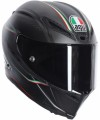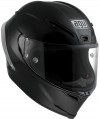Visor
The type of visor used in the helmet. In this case, a visor means glass that covers the motorcyclist’s face from wind, dust, raindrops, etc., and often also from the bright sun. Note that there is a specific category of visors - sun protection; they are not taken into account in this case; for more information about such devices, see “Functions/capabilities”. Traditional visors can be like this:
-
Transparent. Classic transparent glass that does not change the visible image. In bright sunshine, such visors are less comfortable than tinted ones, but this disadvantage can be compensated for by using additional sun visors (see below). At the same time, transparent glasses do not impair visibility in the twilight and are generally more versatile, and therefore are used in most helmets that generally have visors.
—
Tinted. Visors with tinting. As a rule, we are talking about a certain degree of shading - from light “smoky” to almost black or mirror (glasses tinted yellow or orange have their own specifics, so they are indicated separately - see below). The darkened visor improves visibility in bright sunshine; in addition, it is often made polarized, which also reduces the amount of visible glare (from water, from shiny metal surfaces, etc.). On the other hand, through such glass it is worse to see in the evening and at night than through transparent glass - up to the complete impossibili
...ty of using a helmet with a closed “visor” normally. So tinted visors are recommended for daytime driving only.
— Tinted/transparent. This option is indicated for models available in different configuration options - both with a tinted and with a transparent visor. This allows you to choose the option at your discretion, depending on personal preferences and expected driving characteristics. And some models can be equipped with both types of glass, which makes the helmet universal right out of the box.
- Yellow. Visor tinted yellow or orange. These glasses are the opposite of tinted visors: the yellow color increases image brightness and contrast, improving visibility in low light conditions - from cloudy weather to evening and night driving. But in daylight, even not very bright, the yellow color can cause discomfort (although it all depends on the user’s preferences). In general, this is a rather specific category; it is rarely installed in helmets as standard: it is believed that the need for yellow glass rarely arises, and if it does arise, such a visor can be purchased separately without any problems.
- Absent. By definition, cross-over helmets designed for use with glasses do not have visors; In addition, glass is missing in some open models (see "Type"), in which such equipment does not fit due to construction or design considerations. But in other types of helmets this option practically does not occur: if a given model allows the installation of a visor, it is almost certainly equipped with at least the simplest transparent glass.Shell material
The material from which the shell is made is the outer hard shell of the helmet.
—
Thermoplastic. Material used primarily in inexpensive motorcycle helmets; the most popular option in this category. Thermoplastic (most often it is polycarbonate) is notable for its low cost and has quite sufficient, although not very high, strength characteristics, but it is quite heavy, besides, it “ages” with use due to temperature changes and exposure to ultraviolet radiation; These helmets are recommended to be changed every 5 years.
—
Thermoresin. In terms of basic properties, this material is similar to the plastic described above; at the same time, it is more durable and durable, however, it also costs a little more, which accordingly affects the price of helmets.
—
Fibreglass (fibreglass). In this case, we are not talking about pure glass fibre, but about fibreglass — a composite consisting of fibreglass and a plastic base. Sufficiently strong and reliable, but at the same time quite heavy material, used mainly in mid-level helmets.
—
Carbon. It is also carbon fibre — a composite material that combines carbon fibre and a polymer resin base. This combination allows you to achieve lightness and at the same time extremely high strength, but it is not cheap. Therefore, a carbon fibre shell is usually a si
...gn of a premium helmet.
— Fibreglass / Kevlar. The fibreglass described above, supplemented with a composite based on another fibre — Kevlar. Kevlar is not much inferior to carbon in terms of strength, while it costs less, and such material weighs noticeably less than fibreglass, which significantly affects the mass of the entire helmet. In this case, the materials are usually arranged in layers.
— Carbon / fibreglass. Helmets partly made of carbon, partly made of fibreglass; such a shell usually has a "puff" construction. About the features of each of these materials, see above, and their combination allows you to combine the advantages and partially compensate for the shortcomings. So, such combined helmets are cheaper than pure carbon ones, and in terms of strength they may not be inferior to them. However fibreglass is a heavy material, which accordingly affects the weight; however, such helmets still turn out to be quite light.
— Carbon / Kevlar. Helmets that combine carbon and Kevlar in construction — usually in the form of layers that make up the shell. Both of these materials are detailed above, and the combination is remarkable for its high strength and lower cost than pure carbon. At the same time, these helmets are still expensive, and weigh a little more than carbon ones.Safety certification
Safety certification or certifications to which the helmet conforms. To date, the following types of certificates are found in motorcycle helmets:
—ECE 22.05. The European certification system, which provides for very strict requirements for safety testing among national and international standards (except that in the ACU the requirements can be even tougher). According to ECE 22.05, each batch of helmets must be tested before being sent for sale (for this, several test items are selected), and the testing itself is quite strict and takes into account the fact that motorcyclists' heads can have different sizes and weights. Helmets certified according to this standard are used even in professional motorsport (although, of course, products of different levels and purposes can pass certification).
—
Snell. Also known as SMF. Standard developed and used in the USA; appeared in the mid-1950s, and has been regularly improved and refined since then. Snell's requirements are more relaxed than ECE 22.05, but tougher than DOT: products must undergo constant quality control, and the test takes into account the possible difference in head size (although it does not take into account the difference in weight).
— DOT. The standard was developed by the US Department of Transportation back in 1972 and has remained virtually unchanged since then. It provides for very mild conditions for b
...oth the testing itself and the control of the results. So, the check is carried out only for the standard size and weight of the head, the manufacturer himself does this and he also determines whether his products comply with DOT requirements, and control by the Ministry of Transport is limited to periodic selective testing. However, even with this in mind, having a DOT is much preferable to no certification at all.
— ACU. A standard developed and maintained by the British Motorcycle Union (Auto-Cycle Union), a public organization representing the interests of the motorcycle community. Provides two main marking options — ACU Gold and ACU Silver; however, the second option is extremely rare for a number of reasons, and it is usually the top, “gold” marking that is used. In order to be ACU Gold certified, a helmet must not only meet certain generally accepted standards (described above by Snell 2005 or ECE 22.05, British BSI Type A, etc.), but also be tested according to ACU rules, which require additional checks. As a result, the ACU Gold marking corresponds to a very high level of safety. Note that some time ago this system was at the centre of a scandal: there were rumors that “ACU Gold” stickers are sold freely and can be found even on low-quality helmets that have not passed (and are not able to pass) an official test. However, the ACU organization has taken steps to correct the situation, and conscientious sellers do not go for such a deception. However, if you have any doubts, you can check from official sources (for example, the ACU website on the Internet) whether the selected helmet meets the safety level claimed for it.
